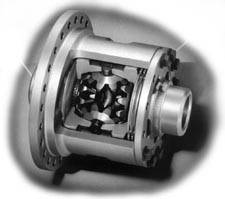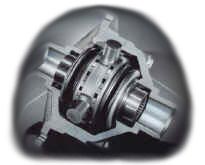
Diff Locks

By Mark Peacock
The installation of a diff lock on your vehicle somehow adds that mystical quality to your 4WD standing. Some people choose not to let on their ‘secret’ and attempt to cultivate a driving reputation of ‘4WD legend’ status. Others boast to all and sundry of their installation and then fail to deliver the magical performance now expected. But really, what is all the hype about diff locks, and is it deserved?
To set the record straight, the diff lock fitted as standard equipment to all permanent 4WD’s does nothing more than make it the same as the "lesser" part-time 4WD’s when in four wheel drive. A permanent 4WD has a centre differential whereas a part-time 4WD does not. The diff lock only locks the centre diff and has nothing to do with the differential on the front and rear axles.
 The diff lock most 4WDrivers talk about, and the one
refered to in this article, is when its fitted to the front or rear axle of the vehicle.
Its here that the mystic begins. A ‘normal’ differential transmits drive to both
wheels equally when they receive equal traction, but when one wheel loses traction, the
diff actually transmits more drive to that wheel. Hence you can become stuck in 2WD with
only one wheel bogged. Similairly, when in 4WD you can be bogged with one front and one
rear wheel without traction. So your 4WD is really only a 2WD, with one front and one rear
wheel providing all forward momentum.
The diff lock most 4WDrivers talk about, and the one
refered to in this article, is when its fitted to the front or rear axle of the vehicle.
Its here that the mystic begins. A ‘normal’ differential transmits drive to both
wheels equally when they receive equal traction, but when one wheel loses traction, the
diff actually transmits more drive to that wheel. Hence you can become stuck in 2WD with
only one wheel bogged. Similairly, when in 4WD you can be bogged with one front and one
rear wheel without traction. So your 4WD is really only a 2WD, with one front and one rear
wheel providing all forward momentum.
To overcome this limitation many vehicle manufacturers fit a limited slip differential (LSD) to the rear of most new 4WDs. A LSD is an improvement to the open differential but, as its name implies, it only provides limited drive to the wheel that has traction. To appreciate just how ‘limited’ the slip is, try the following test. With a vehicle fitted with a rear LSD, place an axle stand to lift one of its rear wheels off the ground and then chock both front wheels with a brick. The LSD will not provide enough torque to drive the vehicle over the brick (vehicle obviously in 2WD). If a diff lock was fitted then the vehicle would drive forward easily.
 In many
offroad circumstances the traction avaliable to the rear wheels is similair and the LSD
can control any wheelspin. However as soon as there is a large difference in traction ie.
one wheel off the ground, there is no way a LSD will have any beneficial effect. The
reason the diff lock is so effective is that it provides equal drive to each wheel,
regardless of traction. When a diff lock is fitted to both front and rear, a vehicle has
to loose traction to all four wheels before it stops.
In many
offroad circumstances the traction avaliable to the rear wheels is similair and the LSD
can control any wheelspin. However as soon as there is a large difference in traction ie.
one wheel off the ground, there is no way a LSD will have any beneficial effect. The
reason the diff lock is so effective is that it provides equal drive to each wheel,
regardless of traction. When a diff lock is fitted to both front and rear, a vehicle has
to loose traction to all four wheels before it stops.
Diff locks obviously provide more traction but their effect is more dramatic in certain terrain types. The greatest improvement comes on deeply gouged rocky tracks where there is plenty of traction and the rough ground results in opposite wheels not touching the track. The least improvement comes in smooth slippery tracks where all wheels have roughly the same weight on them but there is simply not enough traction. It is quite common in these circumstances for all four wheels to spin even when diff locks are not fitted.
A diff lock is not some magical device that can create more traction for your vehicle, all it can do is make avaliable the same amount of torque to each wheel. In simplistic terms, a four wheel drive vehicle is only a 2WD whereas a front and rear diff locked vehicle is a true 4WD. In pratical terms, a vehicle with front and rear diff locks will go places that no ordinary 4WD can.
 So
now you can see why to fit a diff lock, but what type? And if fitting to only one diff, is
a front or rear fitment more effective. First of all, its better to explain the different
types of lockers commonly avaliable. The three most common brands of diff locks comprise
of essentially two different types. The Detroit Locker and the Lock Right
are an automatic locker that are always in operation. They work by leaving the diff locked
and automatically unlocking it when required. Without getting technical, they work by
transmitting drive equally to both wheels but allow a wheel to turn faster than driven
speed, such as required when cornering. The ARB diff lock is operated by a switch
when required and locks the diff completely. It does not allow any difference in wheel
speed on the same axle.
So
now you can see why to fit a diff lock, but what type? And if fitting to only one diff, is
a front or rear fitment more effective. First of all, its better to explain the different
types of lockers commonly avaliable. The three most common brands of diff locks comprise
of essentially two different types. The Detroit Locker and the Lock Right
are an automatic locker that are always in operation. They work by leaving the diff locked
and automatically unlocking it when required. Without getting technical, they work by
transmitting drive equally to both wheels but allow a wheel to turn faster than driven
speed, such as required when cornering. The ARB diff lock is operated by a switch
when required and locks the diff completely. It does not allow any difference in wheel
speed on the same axle.
The advantage of the automatic lockers is that they allow one wheel to overspeed, thus allowing easier cornering. When fitted to the front diff, this allows steering control to be easily maintained whereas a locked diff tends to go straight ahead. Proponents of locking diffs point out that the diff can be turned off to allow steering control or that it should only be used when traction is so poor it makes no difference to steering. In practice, it is a definite advantage to maintain steering control. However, an automatic locker should not be fitted to the front diff of permanent four wheel drives as it has a noticable effect on steering when on reasonable traction surfaces. When a part-time 4WD is in 2WD there is no effect what so ever on the steering from an auto diff lock. A permanent 4WD’s only option for the front diff is an ARB locker.
The rear axle can have either an automatic locker or ARB locker regardless of being a permanent or part-time 4WD. The overspeed advantages of an automatic locker are minimal on a rear axle fitting as far as steering effect are concerned. The biggest difference is that an automatic locker is ALWAYS working whether in 2 or 4 wheel drive or on dirt or bitumen. In practice, this results in being able to go most places in 2WD whereas 4WD would have been required previously. It is still good practice however to use 4WD as soon as pratical when on dirt as it minimises the impact on the enviroment.
An ARB locker should only be used in the dirt when traction is so poor that one wheel is close to loosing traction, otherwise axle windup may occur if used on good traction surfaces. At this point, it may seem that automatic lockers have it all over the ARB locker but its not quite that cut and dried. Even when fitted to the rear there is an effect on the vehicle by an auto locker as it cams in and out. It is more noticable in short wheel based petrol powered vehicles than in long wheel based diesel vehicles, where the effect is minimal. It occurs mainly when getting off and on the gas in corners and has a lot to do with driving style. It shows up as an audible clicking from the rear and in some circumstances can have a slight understeer effect. Once an auto locker is fitted to the rear this effect will always be present to a varying degree. Most drivers are unaware of this effect, bit if its of any concern you can adapt your driving style to minimise its impact. An ARB locker is only switched on as required so there is no effect during on-road driving.
So now your aware of the differences between the types of lockers avaliable, which is the best place to fit a single diff lock, front or rear? This is actually a loaded question as it depends on the type of terrain and your vehicle type, but in a nutshell I believe the front is the best place. This is especially so for independent front suspension vehicles which easily lift a wheel even on modest terrain. Additionally, most vehicles these days already have a rear LSD so why fit a locker to the rear and leave the front diff open? Its a better option to fit the locker to the front and leave the LSD in place. When the vehicle has open diffs back and front there are still advantages for a front fitment. When in sand or mud the fitting of a locker to the front will have a greater effect. If hill climbs are your main speciality then a rear fitment may be a better choice as there is a significant weight transfer to the rear axle when going uphill. However if the hillclimb requires large rocks, gullies or shelves to be driven over, then a front locker will drive over the obstacle rather than being pushed up it from behind. As you can see, there is no right or wrong answer, just different choices depending on individual factors. (c) 4WD Encounter 1998
Send me some feedback about these pages, by emailing me.
This page was last updated on 11th June 2002